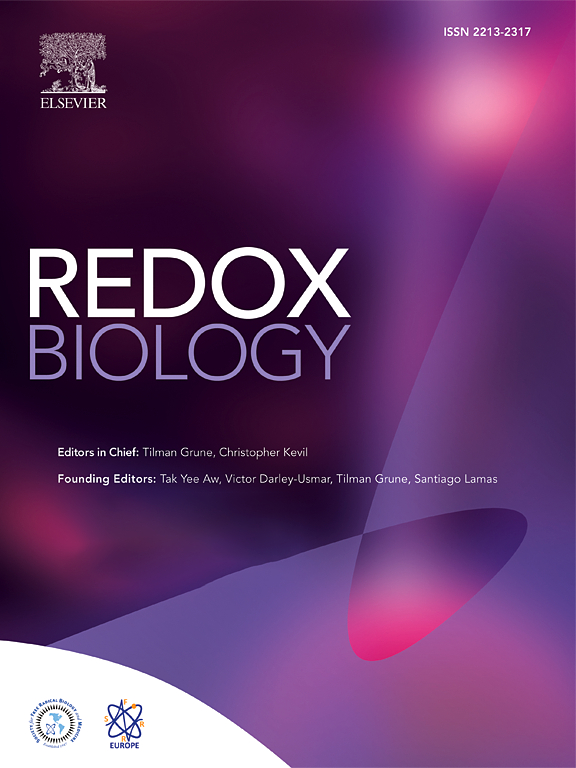SREBP1 诱导介导了 TIIDM 小鼠长期他汀类药物治疗相关的心肌脂质过氧化和脂质沉积。
IF 10.7
1区 生物学
Q1 BIOCHEMISTRY & MOLECULAR BIOLOGY
引用次数: 0
摘要
他汀类药物能有效降低糖尿病患者发生重大心血管事件的风险。然而,我们的研究发现,长期服用他汀类药物与 II 型糖尿病(TIIDM)患者心肌功能障碍风险升高之间存在关联。在此,我们报告了他汀类药物治疗后诱导固醇调节元件结合蛋白 1(SREBP1)活化、相关脂质过氧化以及由此导致的糖尿病心肌功能障碍,并探讨了其潜在机制。在 db/db 小鼠中,我们观察到服用阿托伐他汀(5 和 10 毫克/千克)和罗苏伐他汀(20 毫克/千克)40 周后,通过超声心动图和心肌细胞收缩力测定会加剧糖尿病心肌功能障碍,通过 CD68、IL-1β、Masson 染色和胶原蛋白 1A1 免疫组织化学(IHC)染色会增加心肌炎症和纤维化,通过代谢笼系统评估会增加呼吸交换比(RER)、透射电子显微镜(TEM)检查显示线粒体结构病理变化加剧,TEM、油红和周期性酸-希夫染色法(PAS)染色显示脂质和糖原沉积增加,与之相对应的是心肌 SREBP1 蛋白和脂质过氧化物(4-羟基壬烯醛,4-HNE)染色显示心肌 SREBP1 蛋白和脂质过氧化物水平升高。在 KK-ay 和低剂量链脲佐菌素(STZ)诱导的 TIIDM 小鼠中也观察到了类似的心肌纤维化。在糖尿病患者的心脏组织中观察到 SREBP1 水平升高,这与他们的心肌功能障碍呈正相关。为了阐明他汀诱导的 SREBP1 在脂质过氧化和脂质沉积中的作用及相关机制,我们培养了新生小鼠原代心肌细胞(NMPCs),并用阿托伐他汀(10 μM,24 小时)处理,用[U-13C]-葡萄糖追踪并评估 SREBP1 的表达和定位。我们发现,他汀类药物治疗可提高新生脂肪生成(DNL)和 SREBP1 裂解激活蛋白(SCAP)的水平,减少 SCAP 与胰岛素诱导基因 1(Insig1)的相互作用,并增强 SCAP/SREBP1 向高尔基体的转位,从而促进 SREBP1 裂解,导致其在 NMPC 中的核跨定位和激活。最终,在低剂量 STZ 处理的 SREBP1+/- 小鼠和左旋肉碱处理的 db/db 小鼠中,SREBP1 敲除或左旋肉碱减轻了长期他汀类药物治疗诱导的脂质过氧化和心肌纤维化。总之,我们证明他汀类药物治疗可通过激活 SREBP1 增加 DNL,导致心肌脂质过氧化和脂质沉积。本文章由计算机程序翻译,如有差异,请以英文原文为准。
SREBP1 induction mediates long-term statins therapy related myocardial lipid peroxidation and lipid deposition in TIIDM mice
Statins therapy is efficacious in diminishing the risk of major cardiovascular events in diabetic patients. However, our research has uncovered a correlation between the prolonged administration of statins and an elevated risk of myocardial dysfunction in patients with type II diabetes mellitus (TIIDM). Here, we report the induction of sterol regulatory element-binding protein 1 (SREBP1) activation, associated lipid peroxidation, and the consequent diabetic myocardial dysfunction after statin treatment and explored the underlying mechanisms. In db/db mice, we observed that 40 weeks atorvastatin (5 and 10 mg/kg) and rosuvastatin (20 mg/kg) administration exacerbated diabetic myocardial dysfunction by echocardiography and cardiomyocyte contractility assay, increased myocardial inflammation and fibrosis as shown by CD68, IL-1β, Masson's staining and Collagen1A1 immunohistochemistry (IHC) staining, increased respiratory exchange ratio (RER) by metabolic cage system assessment, exacerbated mitochondrial structural pathological changes by transmission electron microscopy (TEM) examination, increased deposition of lipid and glycogen by TEM, Oil-red and periodic acid-schiff stain (PAS) staining, which were corresponded with augmented levels of myocardial SREBP1 protein and lipid peroxidation marked by 4-hydroxynonenal (4-HNE) staining. Comparable myocardial fibrosis was also observed in KK-ay and low-dose streptozotocin (STZ)-induced TIIDM mice. Elevated SREBP1 levels were observed in the heart tissues from diabetic patients, which was positively correlated with their myocardial dysfunction. To elucidate the role of statin induced SREBP1 in lipid peroxidation and lipid deposition and related mechanism, we cultured neonatal mouse primary cardiomyocytes (NMPCs) and treated them with atorvastatin (10 μM, 24 h), tracing with [U–13C]-glucose and evaluating for SREBP1 expression and localization. We found that statin treatment elevated de novo lipogenesis (DNL) and the levels of SREBP1 cleavage-activating protein (SCAP), reduced the interaction of SCAP with insulin-induced gene 1 (Insig1), and enhance SCAP/SREBP1 translocation to the Golgi, which facilitate SREBP1 cleavage leading to its nuclear trans-localization and activation in NMPCs. Ultimately, SREBP1 knockdown or l-carnitine mitigated long-term statins therapy induced lipid peroxidation and myocardial fibrosis in low-dose STZ treated SREBP1+/− mice and l-carnitine treated db/db mice. In conclusion, we demonstrated that statin therapy may augment DNL by activating SREBP1, resulting in myocardial lipid peroxidation and lipid deposition.
求助全文
通过发布文献求助,成功后即可免费获取论文全文。
去求助
来源期刊

Redox Biology
BIOCHEMISTRY & MOLECULAR BIOLOGY-
CiteScore
19.90
自引率
3.50%
发文量
318
审稿时长
25 days
期刊介绍:
Redox Biology is the official journal of the Society for Redox Biology and Medicine and the Society for Free Radical Research-Europe. It is also affiliated with the International Society for Free Radical Research (SFRRI). This journal serves as a platform for publishing pioneering research, innovative methods, and comprehensive review articles in the field of redox biology, encompassing both health and disease.
Redox Biology welcomes various forms of contributions, including research articles (short or full communications), methods, mini-reviews, and commentaries. Through its diverse range of published content, Redox Biology aims to foster advancements and insights in the understanding of redox biology and its implications.
 求助内容:
求助内容: 应助结果提醒方式:
应助结果提醒方式:


